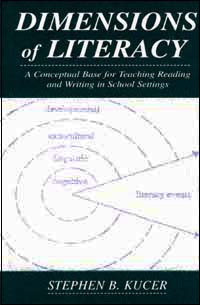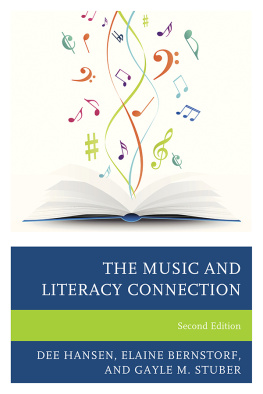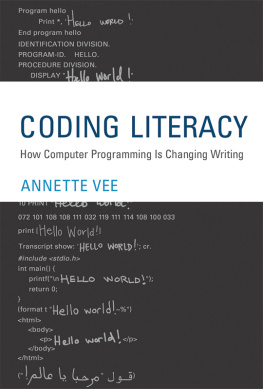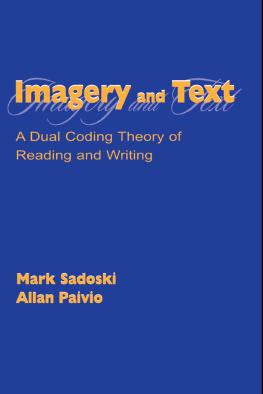Cover

| title | : | Dimensions of Literacy : A Conceptual Base for Teaching Reading and Writing in School Settings |
| author | : | Kucer, Stephen B. |
| publisher | : | Lawrence Erlbaum Associates, Inc. |
| isbn10 | asin | : | 0805831614 |
| print isbn13 | : | 9780805831610 |
| ebook isbn13 | : | 9780585386652 |
| language | : | English |
| subject | Language arts, Reading, English language--Composition and exercises--Study and teaching, Literacy--Social aspects, Sociolinguistics. |
| publication date | : | 2001 |
| lcc | : | LB1576.K83 2001eb |
| ddc | : | 428.6 |
| subject | : | Language arts, Reading, English language--Composition and exercises--Study and teaching, Literacy--Social aspects, Sociolinguistics. |
Page i
Dimensions of Literacy
A Conceptual Base for Teaching
Reading and Writing in School Settings
Page ii
This page intentionally left blank
Page iii
Dimensions of Literacy
A Conceptual Base for Teaching
Reading and Writing in School Settings
Stephen B. Kucer
Fordham UniversityLincoln Center

Page iv
Copyright 2001 by Lawrence Erlbaum Associates, Inc.
All rights reserved. No part of this book may be reproduced in any form, by photostat, microfilm, retrieval system, or any other means, without prior written permission of the publisher.
Lawrence Erlbaum Associates, Inc., Publishers
10 Industrial Avenue
Mahwah, NJ 07430
Cover design by Kathryn Houghtaling lacey
Library of Congress Cataloging-in-Publication Data
Kucer, Stephen B., 1950.
Dimensions of literacy : a conceptual base for teaching reading
and writing in school settings / Stephen B. Kucer.
p. cm.
Includes bibliographical references and index.
ISBN 0-8058-3161-4 (cloth : alk. paper)
ISBN 0-8058-3162-2 (pbk. : alk. paper)
1. Language arts. 2. Reading. 3. English languageComposition
and exercisesStudy and teaching. 4. LiteracySocial aspects.
5. Sociolinguistics. I. Title.
LB1576 .K83 2001
428.6dc21 00-067762
CIP
Books published by Lawrence Erlbaum Associates are printed on acid-free paper, and their bindings are chosen for strength and durability.
Printed in the United States of America
10 9 8 7 6 5 4 3 2 1
Page v
Contents
Preface | ix |
Introduction |
1 A Multidimensional View of Reading and Writing | |
Disciplinary Perspectives Versus Literacy Dimensions | |
A Literacy Beliefs Profile | |
A Literacy Story | |
About This Book | |
I: The Linguistic Dimension of Literacy |
2 The Nature of Language | |
What Makes Language Language? | |
The Systems of Language | |
Context, Situation, and the Systems of Language | |
OralWritten Language Relationships | |
Conclusions | |
3 Language Variation | |
What Is Language Variation? | |
Causes of Language Variation | |
Page vi
Language Variation and the Reading and Writing Processes | |
The Impact of Various Forms of Spoken English on Literacy Development | |
Conclusions | |
Revisiting What Makes Language Language | |
The Linguistic Dimension of the Literacy Story | |
II: The Cognitive Dimension of Literacy |
4 The Constructive Nature of Perception | |
Perceptual Experiments | |
The Systems of Language, Memory, and Perception | |
Visual Processing and Memory | |
"A Pin for Dan" and "The Great Big Enormous Turnip" | |
Conclusions | |
5 The Reading and Comprehending Processes | |
Factors Influencing the ReaderTextWriter Transaction | |
What Do Theories and Models Have To Do With Teaching? | |
A Theory and Model of the Reading Process | |
An Examination of Proficient and Nonproficient Readers | |
Biliterate Readers | |
Reading: Another View | |
Understanding and Interpreting Written Discourse | |
Conclusions | |
6 The Writing Process | |
Revisiting the ReaderTextWriter Transaction | |
A Theory and Model of the Writing Process | |
An Examination of Proficient and Nonproficient Writers | |
Page vii
Cognitive Interrelationships Between the Reading and Writing Processes | |
Conclusions | |
The Cognitive Dimension of the Literacy Story | |
III: The Sociocultural Dimension of Literacy |
7 Understanding Literacy as Social Practices | |
Examining Our Own Literacy Practices | |
Group Memberships and Social Identity | |
Literacy and Social Practices | |
Literacy in School and Out | |
Literacy and Its Relationship to Cognitive and Socioeconomic Development | |
Conclusions | |
8 The Authority of Written Discourse | |
The Nature of Knowledge | |
The Nature of Texts and Text Interpretation | |
Conclusions | |
The Sociocultural Dimension of the Literacy Story | |
IV: The Developmental Dimension of Literacy |
9 Constructing the Written Language System | |
Why Learn Language? | |
Developmental Patterns and Principles | |
Interrelationships Between Reading and Writing Development | |
Variations on a Theme: Culture and Literacy Development | |
Conclusions | |
The Developmental Dimension of the Literacy Story | |
Next page










